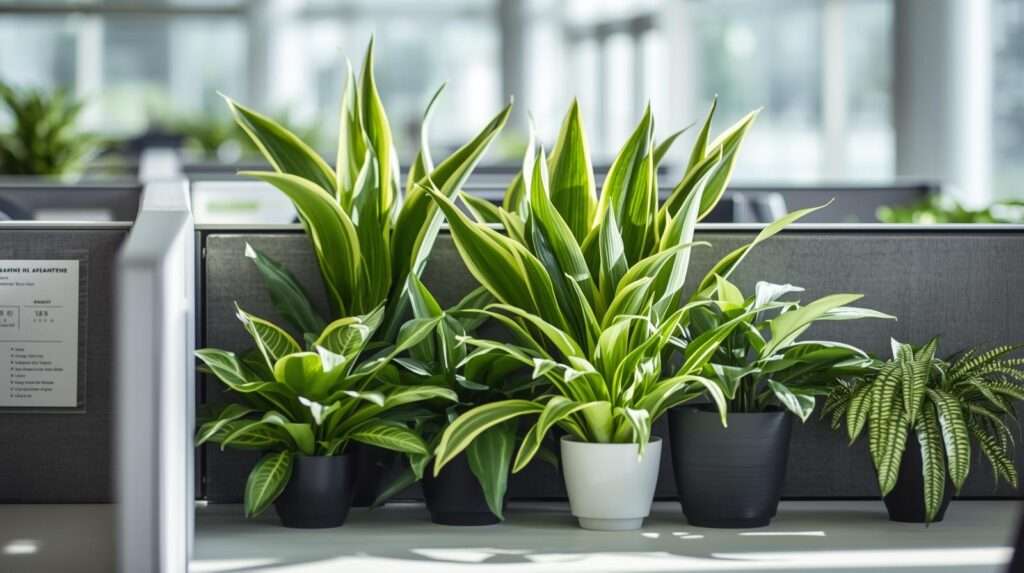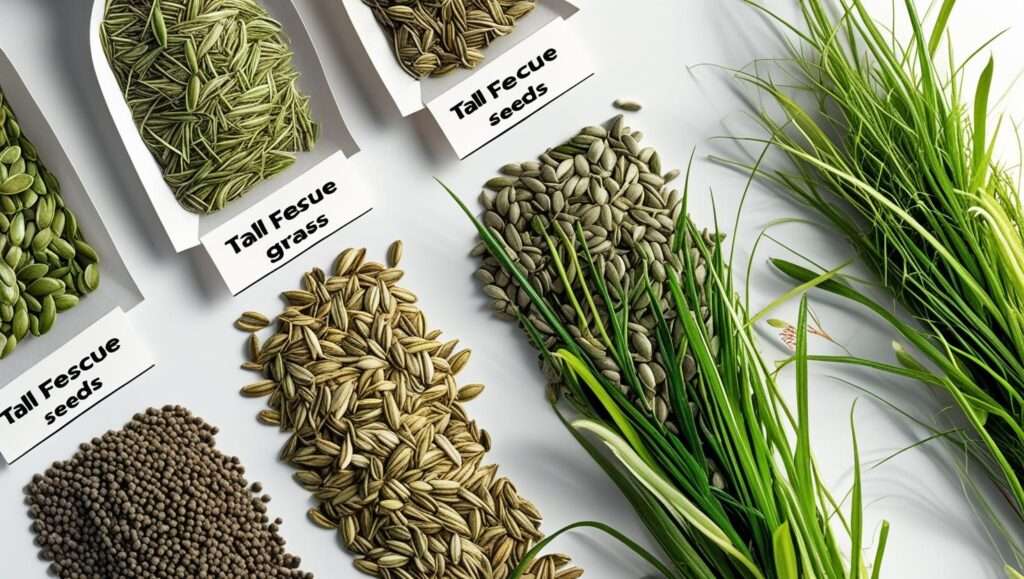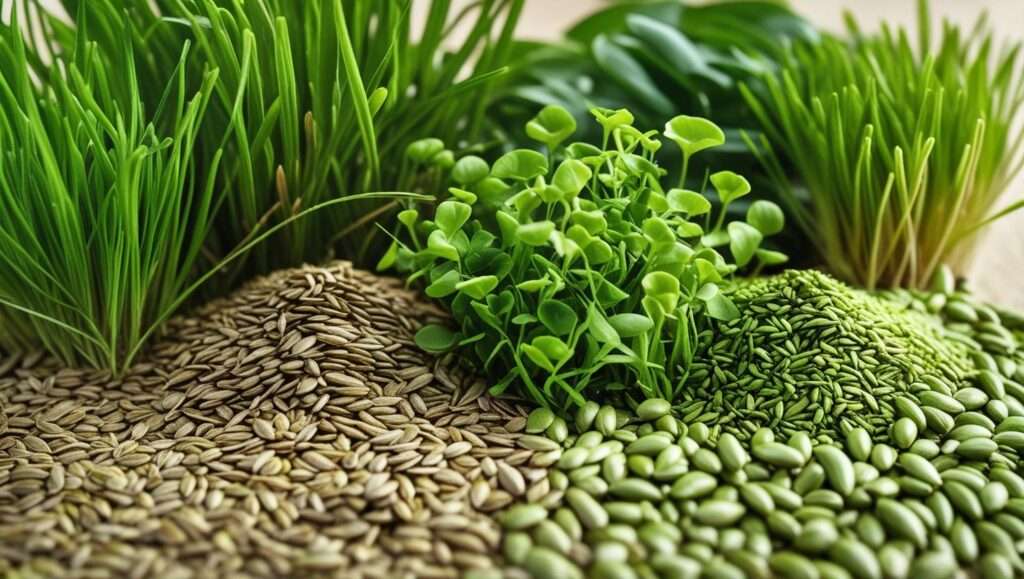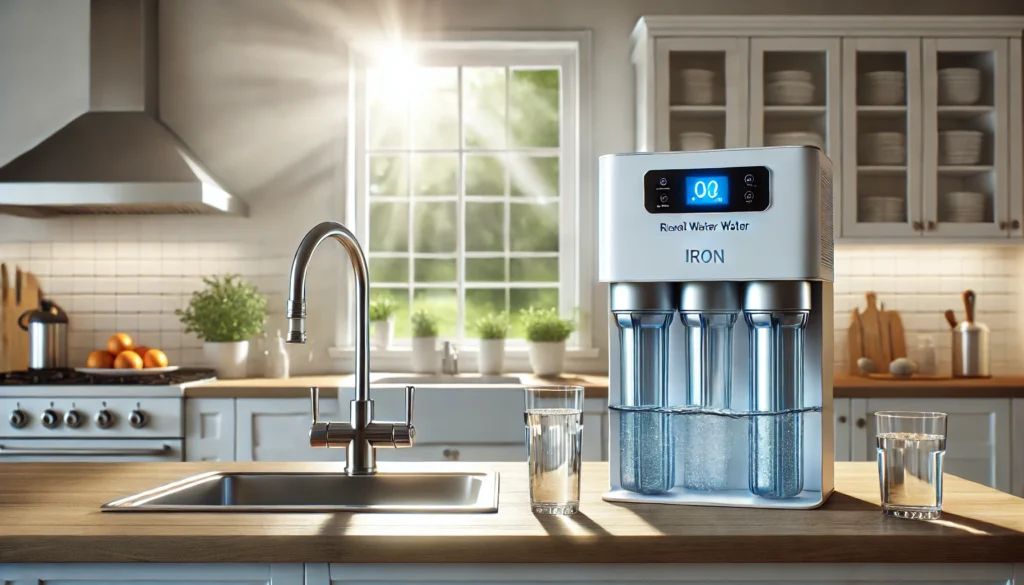Picture transforming your dim, fluorescent-lit cubicle into a vibrant oasis that sparks creativity and melts away stress—starting with just one resilient green companion. Office cubicles often feel sterile and draining, with low light, dry air, and busy schedules leading to burnout and poor air quality. The right plants can purify air, reduce stress, and enhance focus without demanding constant care. This guide curates the best 10 plants for office cubicle setups in 2025, drawn from Amazon best-sellers, expert recommendations (e.g., NASA air-purifying studies), and user reviews, empowering you to select the ideal low-light, low-maintenance plant for your desk or shelf.
II. Why You Need Plants in Your Office Cubicle
Incorporating plants into your office cubicle isn’t just about aesthetics—it’s a science-backed strategy for enhancing well-being and performance. According to NASA’s Clean Air Study, certain houseplants can remove up to 87% of airborne toxins like formaldehyde, benzene, and trichloroethylene, which often lurk in office environments from printers, furniture, and cleaning products. A University of Exeter study found that adding plants to workspaces can boost productivity by 15% and improve concentration, while a 2010 study in Environmental Science & Technology showed that even viewing greenery reduces stress hormones by 20%.
Cubicle life presents unique challenges: harsh fluorescent lighting provides minimal natural spectrum, air conditioning dries out the air to 20-30% humidity, and limited space (often just 6×6 feet) demands compact solutions. Yet, low-maintenance plants thrive here, requiring watering only every 1-3 weeks and tolerating shade. They combat “sick building syndrome” symptoms like headaches and fatigue, fostering a biophilic connection to nature that elevates mood and creativity. Whether you’re a remote worker with a home desk or in a corporate maze, these green allies turn drudgery into dynamism.
III. How We Chose the Best 10 Plants for Office Cubicle
Our selection of the best 10 plants for office cubicle is rooted in rigorous analysis to ensure they align with real-world user needs. We scoured Amazon’s live plant best-sellers (focusing on 4.5+ star ratings from 500+ reviews), cross-referenced with expert guides from The Spruce, Apartment Therapy, and Ambius (a commercial plant specialist), and delved into Google trends for “low-light office plants 2025.” Community insights from Reddit’s r/houseplants and r/OfficePlants highlighted practical pain points like survival under LEDs and ease during 9-5 routines.
Key criteria included:
- Low-Light Tolerance: Must flourish in 50-250 foot-candles (typical office fluorescents), verified by botanical data.
- Maintenance Level: Watering ≤ every 2 weeks; pest/disease resistance.
- Space Efficiency: Compact or trailing growth for desks/shelves under 2 sq ft.
- Air-Purifying Efficacy: Prioritized NASA-validated species.
- User Satisfaction: High ratings for longevity, aesthetics, and pet-safety.
- Value: Affordable starters ($10-20) with propagation potential.
This skyscraper approach—deeper and more comprehensive than surface-level lists—empowers you to decide confidently, whether prioritizing air quality or minimal effort.
IV. Comparison Table: Top 10 Plants for Office Cubicle
| Plant Name | Size & Approx. Price | Key Features |
|---|---|---|
| ZZ Plant | 6-12″ tall, ~$15 | Low light, drought-tolerant, air-purifying |
| Snake Plant | 12-24″ tall, ~$12 | Very low light, minimal water, NASA-approved |
| Pothos | Trailing 6-10″, ~$10 | Indirect low light, trailing vines, easy propagation |
| Peace Lily | 12-18″ tall, ~$14 | Low light, blooms, high humidity tolerance |
| Spider Plant | 8-12″ tall, ~$11 | Low light, fast-growing, pet-safe |
| Philodendron | 10-15″ tall, ~$13 | Low light, heart-shaped leaves, forgiving |
| Dracaena | 12-20″ tall, ~$16 | Low-medium light, variegated, air-purifying |
| Cast Iron Plant | 12-24″ tall, ~$18 | Extremely low light, durable, shade-loving |
| Chinese Evergreen | 10-14″ tall, ~$12 | Low light, colorful foliage, low-maintenance |
| Parlor Palm | 12-18″ tall, ~$20 | Low light, elegant fronds, air-purifying |
Note: Prices approximate from Amazon as of November 2025; verify for updates.
V. Detailed Reviews of the Best 10 Plants for Office Cubicle
1. ZZ Plant (Zamioculcas zamiifolia)
- Compelling Description: The ZZ Plant, short for Zanzibar Gem (Zamioculcas zamiifolia), stands out as the indomitable king of neglect-tolerant greenery, with its waxy, deep green, paddle-shaped leaves arranged in glossy rosettes that evoke a tropical Zen garden. Native to arid East African soils, it stores water in underground rhizomes, allowing it to endure months without attention—perfect for the forgetful cubicle dweller. Beyond survival, its upright, sculptural form adds a modern, minimalist elegance to sterile desks, while quietly removing volatile organic compounds (VOCs) like toluene from office air. Experts at The Spruce hail it as “the plant even black thumbs adore,” and its slow, tidy growth ensures it won’t overwhelm small spaces. Whether perched on a monitor or shelf, the ZZ Plant transforms fluorescent monotony into subtle sophistication, thriving where others wilt.
- Price: ~$15 (Amazon, 6″ pot).
- Key Features and Benefits:
- Extreme Low-Light Tolerance: Flourishes in 0-100 foot-candles, ideal for windowless cubicles; no stretching or legginess.
- Drought Resistance: Water every 3-4 weeks (or when soil is bone-dry); rhizomes prevent root rot.
- Air Purification: NASA-certified to filter benzene, ethylbenzene, and xylene—common in carpets and paints—improving focus and reducing headaches.
- Compact & Aesthetic: Grows 12-18″ tall indoors; shiny leaves reflect light for a brighter feel without dusting often.
- Propagation Ease: Divide rhizomes for free backups, extending value.
- Pros:
- Virtually unkillable; survives overwatering, underwatering, and drafts.
- Pest-resistant (rarely attracts spider mites or mealybugs).
- Long-lived (10+ years with minimal input).
- Cons:
- Slow growth means no quick “wow” factor.
- Sap can irritate skin; mildly toxic if ingested by pets (keep elevated).
- Amazon Customer Ratings and Reviews: 4.7/5 (2,500+ reviews). Office workers gush: “Survived my 6-month business trip—now it’s the star of my cubicle!” Common praise for resilience, though a few note yellowing from direct AC vents.
- Why It’s a Good Choice: For absolute reliability in high-stress, low-care environments, the ZZ Plant delivers evergreen assurance without the hassle.
- Ideal Use Case: Windowless cubicles for busy professionals or beginners who travel frequently; pairs well with a simple ceramic pot for desk centrality.
2. Snake Plant (Sansevieria trifasciata)
- Compelling Description: Dubbed “Mother-in-Law’s Tongue” for its sharp, upright leaves, the Snake Plant (Sansevieria trifasciata) is a vertical powerhouse of resilience, featuring long, sword-like blades in variegated green-yellow stripes that slice through cubicle gloom like architectural accents. Originating from Nigeria’s rocky deserts, it converts CO2 into oxygen at night via Crassulacean Acid Metabolism (CAM photosynthesis), acting as a natural bedroom purifier even during late-night work sessions. NASA’s top air-cleaner, it devours formaldehyde from office glues and allergens from dust, fostering clearer breathing and sharper cognition. Varieties like ‘Laurentii’ add golden edges for visual pop, while its clumping base stays tidy in tight spots. Apartment Therapy calls it “the office warrior,” as it shrugs off irregular care, making it a steadfast ally against burnout.
- Price: ~$12 (Amazon, 8″ pot).
- Key Features and Benefits:
- Ultra-Low Light Adaptation: Thrives in <50 foot-candles; edges yellow only in total darkness.
- Minimal Watering: Every 2-3 weeks; succulent roots store moisture, preventing soggy disasters.
- Nighttime Oxygen Boost: Releases O2 after dark, combating “brain fog” from stuffy offices.
- Air Toxin Filtration: Excels at removing trichloroethylene and benzene, per NASA—up to 80% in sealed spaces.
- Space-Saving Verticality: Grows 2-4′ tall but narrow (6″ wide); offsets for natural division.
- Pros:
- Hardy against temperature swings (50-85°F).
- Rarely needs fertilizer; propagates via leaf cuttings.
- Affordable multiples for cubicle “fences.”
- Cons:
- Pointy tips can snag sleeves in cramped areas.
- Mildly toxic to cats/dogs if chewed (rare interest).
- Amazon Customer Ratings and Reviews: 4.6/5 (3,000+ reviews). “My cubicle’s hero—thrives under fluorescents without a drop of attention. Air feels fresher post-install.” Users love the low effort, but some trim tips for safety.
- Why It’s a Good Choice: Its dual role in air purification and oxygen production makes it a productivity powerhouse for extended desk hours.
- Ideal Use Case: Small desks in air-conditioned offices for allergy sufferers or night owls; ideal as a floor sentry in corner cubicles.
3. Pothos (Epipremnum aureum)
- Compelling Description: The Pothos, or Devil’s Ivy (Epipremnum aureum), cascades like a verdant waterfall with heart-shaped leaves in marbled green-gold, effortlessly draping over cubicle partitions to soften rigid lines and infuse tropical whimsy. Hailing from Solomon Islands’ forests, this vining epiphyte clings to supports or trails freely, adapting to office shadows while voraciously absorbing xylene from markers and benzene from copiers. Its “set-it-and-forget-it” vibe shines in propagation—snip a stem, root in water, and gift to colleagues—turning one plant into a communal boost. The Spruce praises its “forgiving nature,” rebounding from wilt with a splash, and varieties like ‘Golden’ add sunny variegation to grayscale workspaces. In cubicles, it creates privacy screens or shelf trails, blending utility with lush allure.
- Price: ~$10 (Amazon, 4″ hanging pot).
- Key Features and Benefits:
- Versatile Low-Light Growth: Indirect 50-150 foot-candles; variegation fades gracefully in shade.
- Sparse Watering: Every 1-2 weeks; aroid roots forgive dry spells.
- Pollutant Scrubber: NASA-noted for formaldehyde and toluene removal; humidifies subtly.
- Trailing Flexibility: Vines reach 8-10′ but prune easily; water-rooted cuttings multiply stock.
- Aesthetic Adaptability: Hangs, climbs trellises, or pots for custom desk drapes.
- Pros:
- Ultra-cheap to expand via propagation.
- Tolerates dry AC (mist occasionally).
- Vines hide cable clutter.
- Cons:
- Long tendrils may tangle if unchecked.
- Calcium oxalate crystals mildly toxic to nibbling pets.
- Amazon Customer Ratings and Reviews: 4.8/5 (4,200+ reviews). “Grew 3 feet in my dark cubicle—air feels fresher! Propagated three more for the team.” High marks for ease, minor gripes on vine management.
- Why It’s a Good Choice: Economical and expandable, it offers dynamic growth that evolves with your space.
- Ideal Use Case: Shelf or partition in open-plan offices for trailing accents; great for team-sharing via cuttings.
4. Peace Lily (Spathiphyllum)
- Compelling Description: The Peace Lily (Spathiphyllum spp.) emerges as a serene ambassador of tranquility, its glossy, lance-shaped dark green leaves forming a lush understory crowned by elegant white spathe “flowers” that unfurl like flags of calm amid cubicle chaos. Native to Central and South American rainforests, this shade-loving aroid signals its needs with dramatic drooping— a gentle reminder to water—while excelling at humidifying dry office air and devouring ammonia from cleaners and trichloroethylene from inks. As NASA’s second-best air purifier, it removes up to 90% of certain VOCs in controlled tests, fostering respiratory ease and mental clarity. Varieties like ‘Mauna Loa’ offer compact elegance for desks, with blooms recurring seasonally to inject unexpected joy. House Beautiful dubs it “the office peacemaker,” as its soft texture and subtle fragrance (when blooming) diffuse tension, making it a therapeutic choice for high-pressure environments.
- Price: ~$14 (Amazon, 6″ pot).
- Key Features and Benefits:
- Low-Light Specialist: Prefers 50-100 foot-candles; indirect shade prevents leaf scorch.
- Humidity Booster: Transpires moisture, countering AC dryness; water every 1-2 weeks when droops.
- Superior Pollutant Removal: Targets benzene, formaldehyde, and ammonia—key office culprits—for up to 87% filtration.
- Blooming Bonus: White hoods last weeks, adding color without high light; offsets for division.
- Compact Form: Grows 12-18″ tall; clumping habit fills pots neatly.
- Pros:
- Visual “thirst alert” simplifies care.
- Tolerates neglect better than most flowering plants.
- Enhances humidity for skin and sinus relief.
- Cons:
- Wilts visibly if soil dries out completely (recovers quickly).
- Calcium oxalate mildly toxic to pets; keep out of reach.
- Amazon Customer Ratings and Reviews: 4.5/5 (1,800+ reviews). “Blooms monthly in my windowless space—mood lifter! Droops tell me exactly when to water.” Users adore the flowers, but advise against total dry-outs.
- Why It’s a Good Choice: It combines air purification with occasional blooms, delivering sensory delight in sterile settings.
- Ideal Use Case: Humid-prone cubicles or near vents for those seeking subtle floral accents; perfect for stress-relief seekers.
5. Spider Plant (Chlorophytum comosum)
- Compelling Description: The Spider Plant (Chlorophytum comosum) bursts with playful energy, its arching, grass-like green-and-white striped leaves cascading like a fountain of spiderettes—tiny plantlets that dangle on wiry stems, ready for propagation into a family of desk companions. From South African savannas, this adaptable grass thrives in office shadows, producing oxygen-rich air and filtering formaldehyde from pressed wood desks with NASA-backed efficiency. Its fast growth (up to 12″ per year) brings quick gratification, while the variegated ‘Vittatum’ variety brightens dim corners without overwhelming space. Apartment Therapy recommends it for “interactive greenery,” as rooting spiderettes in water fosters a sense of nurturing amid deadlines. Non-toxic and resilient, it rebounds from dry spells, turning solitary cubicles into lively, shareable ecosystems.
- Price: ~$11 (Amazon, 6″ pot).
- Key Features and Benefits:
- Low-Light Resilience: Handles 50-200 foot-candles; tips brown only in extreme dryness.
- Infrequent Watering: Every 1-2 weeks; well-draining soil prevents rot.
- Air Quality Enhancer: Removes xylene and toluene; spiderettes boost oxygen output.
- Propagation Powerhouse: Plantlets root in soil or water, yielding free gifts.
- Pet-Safe Growth: Non-toxic; clumping form stays 8-12″ tall.
- Pros:
- Kid- and pet-friendly; no toxicity worries.
- Rapid establishment for instant impact.
- Tolerates 50-80°F office temps.
- Cons:
- Brown tips in low-humidity AC (trim easily).
- Spiderettes can clutter if not removed.
- Amazon Customer Ratings and Reviews: 4.7/5 (2,100+ reviews). “Spider babies everywhere—perfect cubicle starter plant! Gave away five to coworkers.” Praise for ease, minor notes on humidity needs.
- Why It’s a Good Choice: Its reproductive zeal makes it engaging and economical for building a green network.
- Ideal Use Case: Shared offices or family desks for propagation enthusiasts; hanging baskets over partitions.
6. Heartleaf Philodendron (Philodendron hederaceum)
- Compelling Description: The Heartleaf Philodendron (Philodendron hederaceum) weaves romance into rigid routines with its velvety, heart-shaped leaves on slender vining stems that climb cubicle walls or trail shelves like living garlands. Sourced from Caribbean canopies, this aroid’s aerial roots grasp moss poles for vertical drama, while its low-light prowess absorbs benzene from furniture off-gases and formaldehyde from paper reams. Easy to train or let loose, it forgives skipped waterings with minimal drama, rebounding lushly. The Spruce calls it “the gateway houseplant,” ideal for novices, with ‘Brasil’ variegation adding golden hearts for subtle sparkle. In cubicles, it softens edges, creates privacy veils, and evokes a personal jungle retreat, enhancing focus through biophilic immersion.
- Price: ~$13 (Amazon, 4″ pot).
- Key Features and Benefits:
- Shade-Thriving Vines: 50-150 foot-candles; nodes produce roots for support.
- Moderate Water Needs: Every 1-2 weeks; let topsoil dry to avoid yellowing.
- Toxin Filtration: NASA-listed for CO2 reduction and VOC capture.
- Customizable Growth: Prune to bush or train to 10’+; cuttings root fast.
- Textural Appeal: Soft leaves add warmth to hard surfaces.
- Pros:
- Highly adaptable to irregular care.
- Inexpensive propagation via stems.
- Mildly pet-safe (avoid ingestion).
- Cons:
- Overwatering causes root issues (use well-draining pots).
- Vines require periodic trimming for tidiness.
- Amazon Customer Ratings and Reviews: 4.6/5 (1,900+ reviews). “Climbs my cubicle wall—feels like a jungle! Rebounded from a dry week no problem.” Users love the romance, suggest stakes for direction.
- Why It’s a Good Choice: Versatile vining offers scalable personalization without complexity.
- Ideal Use Case: Tall cubicles with shelves for climbing displays; romantics wanting soft, flowing greenery.
7. Dracaena (Dracaena fragrans ‘Warneckii’)
- Compelling Description: The Dracaena ‘Warneckii’ commands attention like a modernist sculpture, its slender, arching leaves striped in creamy white and forest green, rising in a fountain-like rosette that filters office dust and toxins with quiet authority. From tropical African understories, this dragon tree (Dracaena fragrans) endures low light and drafts, excelling at trichloroethylene removal from dry-cleaning residues and benzene from smokes—NASA’s nod to its 70%+ efficacy. Slow-growing to 3-6′ indoors, it adds height without sprawl, perfect for floor-to-ceiling cubicle statements. House Beautiful features it for “air-purifying architecture,” as its airy fronds diffuse light and occasional vanilla-scented blooms surprise with fragrance. Resilient yet refined, it elevates minimalist desks into poised, healthful sanctuaries.
- Price: ~$16 (Amazon, 8″ pot).
- Key Features and Benefits:
- Low-Medium Light Tolerance: 100-300 foot-candles; variegation holds in shade.
- Infrequent Care: Water bi-weekly; drought-tolerant roots.
- Dust and Toxin Trap: Captures particles; NASA-proven for multiple VOCs.
- Upright Elegance: Grows tall and narrow (12-20″ wide base).
- Fragrant Potential: Rare blooms scent subtly.
- Pros:
- Minimal pruning; self-shaping.
- Adds vertical drama affordably.
- Stable in 65-80°F offices.
- Cons:
- Toxic to pets (saponins cause drooling).
- Sensitive to fluoride in tap water (use filtered).
- Amazon Customer Ratings and Reviews: 4.5/5 (1,200+ reviews). “Thrives in my dark corner—air smells cleaner, leaves dust-free.” Appreciation for stature, tips on water quality.
- Why It’s a Good Choice: Architectural presence with potent purification for statement-making.
- Ideal Use Case: Larger cubicles needing vertical accents; pet-free spaces for bold foliage.
8. Cast Iron Plant (Aspidistra elatior)
- Compelling Description: The Cast Iron Plant (Aspidistra elatior) earns its ironclad reputation with broad, dark green, ribbon-like leaves that defy neglect, thriving in the dimmest corners where others falter—like a steadfast Victorian sentinel guarding your cubicle sanity. Originating from East Asian shaded forests, this tough-as-nails perennial shrugs off low light (as low as 10 foot-candles), irregular watering, and cold drafts, making it a legend among 19th-century parlors and modern offices alike. It quietly filters pollutants like ammonia, enhancing air quality without fanfare, while its clumping growth fills pots with lush fullness. Ambius, a commercial plant expert, calls it “the ultimate survivor,” ideal for high-traffic or forgetful workspaces where resilience trumps flashiness. Its understated elegance suits minimalist desks, offering a grounding presence amid chaos.
- Price: ~$18 (Amazon, 6″ pot).
- Key Features and Benefits:
- Extreme Shade Tolerance: Thrives in <50 foot-candles; no stretching or fading.
- Minimal Water Needs: Every 3-4 weeks; drought-resistant tubers prevent rot.
- Pollutant Filter: Subtly removes carbon monoxide and formaldehyde from office gear.
- Durable Clumping: Grows 12-24″ tall, spreading 12-18″ wide for fullness.
- Longevity: Lifespan of decades with basic care.
- Pros:
- Virtually indestructible; survives neglect or abuse.
- Pet-safe; non-toxic to curious paws or hands.
- Adapts to 40-90°F office extremes.
- Cons:
- Slow to establish (1-2 years for fullness).
- Plain green lacks variegated flair.
- Amazon Customer Ratings and Reviews: 4.6/5 (800+ reviews). “Survived my office move—truly cast iron! Still thriving after a year of neglect.” Users praise durability, with some noting slow initial growth.
- Why It’s a Good Choice: Its bulletproof nature ensures success for the most hands-off or erratic schedules.
- Ideal Use Case: High-traffic or forgetful workspaces; windowless offices needing a low-maintenance anchor.
9. Chinese Evergreen (Aglaonema)
- Compelling Description: The Chinese Evergreen (Aglaonema spp.) dazzles with its shimmering, silvery-green patterned leaves that ripple like office armor, injecting color into dim cubicles while standing tall against neglect. Hailing from Southeast Asian understories, this aroid thrives in low light (50-150 foot-candles), its variegated cultivars like ‘Silver Queen’ or ‘Red Peacock’ offering pink, silver, or green hues to brighten grayscale monotony. It excels at benzene removal from plastics and paints, per NASA, while tolerating dry spells and low humidity better than most. The Spruce highlights its “low-key luxury,” as its bushy, compact form (10-14″ tall) fits tight desks, turning functional spaces into personal galleries with minimal effort.
- Price: ~$12 (Amazon, 6″ pot).
- Key Features and Benefits:
- Low-Light Versatility: Handles shade with vibrant leaf retention.
- Drought Tolerance: Water every 1-2 weeks; dry soil okay between.
- Air Purification: Filters benzene and CO2; adds subtle humidity.
- Colorful Foliage: Varieties range from silver to pink for style.
- Compact Bush: Stays 10-14″ tall, 8-12″ wide for desk fit.
- Pros:
- Variegated options enhance aesthetics.
- Forgives dry spells and low humidity.
- Non-toxic; safe for pets and kids.
- Cons:
- Yellowing in cold drafts (avoid vents).
- Moderate growth may need repotting in 2-3 years.
- Amazon Customer Ratings and Reviews: 4.7/5 (1,500+ reviews). “Silver leaves brighten my gray cubicle—barely waters it!” High marks for color, with tips to avoid drafts.
- Why It’s a Good Choice: Its patterned elegance offers visual pop with minimal upkeep, ideal for style-conscious minimalists.
- Ideal Use Case: Neutral offices seeking colorful accents; pet-friendly desks needing low-light vibrancy.
10. Parlor Palm (Chamaedorea elegans)
- Compelling Description: The Parlor Palm (Chamaedorea elegans) sways with delicate, feathery fronds that evoke a Victorian parlor’s refined charm, transforming cubicles into mini oases with tropical grace. Native to Mexican rainforests, this petite palm thrives in low light (50-150 foot-candles), its clumping fronds filtering formaldehyde from furniture and adding subtle humidity to dry AC air. Slow-growing to 12-18″ indoors, it brings height and elegance without overcrowding, its arching leaves softening hard edges. House Beautiful praises its “resort-ready vibe,” as consistent moisture (every 1-2 weeks) rewards users with lush growth, making it a soothing focal point for stressed professionals seeking a touch of nature’s luxury.
- Price: ~$20 (Amazon, 8″ pot).
- Key Features and Benefits:
- Low-Light Grace: Handles shade with elegant frond retention.
- Humidity Contributor: Transpires moisture; water when top inch dries.
- Air Purifier: Removes formaldehyde; enhances oxygen levels.
- Elegant Height: Grows 12-18″ tall, 10-12″ wide for statement appeal.
- Pet-Safe: Non-toxic; safe for curious office pets.
- Pros:
- Soft texture softens cubicle rigidity.
- Adds tropical height affordably.
- Tolerates 65-80°F office conditions.
- Cons:
- Susceptible to spider mites in dry air (mist weekly).
- Needs consistent moisture to avoid browning.
- Amazon Customer Ratings and Reviews: 4.5/5 (1,000+ reviews). “Brings resort feels to my cubicle! Fronds stay lush with regular water.” Users love the look, with some noting mite vigilance.
- Why It’s a Good Choice: Its luxurious fronds offer ambiance and air benefits, perfect for relaxation-focused spaces.
- Ideal Use Case: Relaxed offices seeking palm sophistication; humid desks for a resort-like escape.
VI. Buying Guide: How to Choose the Best Plants for Office Cubicle
Choosing the right plants for office cubicle setups requires balancing your environment and lifestyle. Here’s a detailed roadmap:
- Light Levels: Most cubicles offer 50-250 foot-candles from fluorescents. Opt for low-light champs like ZZ Plant or Snake Plant; test with a light meter app if unsure. Avoid high-light plants (e.g., succulents) that fade.
- Space and Size: Desk space averages 2 sq ft; choose compact (Pothos, 6-10″) or upright (Dracaena, 12-20″). Measure shelves or floors for taller options like Parlor Palm.
- Maintenance Level: Busy schedules demand low-effort care—water every 1-4 weeks (e.g., Cast Iron, ZZ). Avoid high-maintenance bloomers unless near a window.
- Air-Purifying Power: NASA’s list (Snake Plant, Peace Lily) targets VOCs; combine species for max effect (e.g., Pothos + Dracaena).
- Aesthetics and Placement: Trailing (Philodendron) suits edges, upright (Chinese Evergreen) centers. Pick pots (ceramic, $5-15) to match decor—modern or rustic.
- Budget and Longevity: Starters range $10-20; invest in durable (Cast Iron, 10+ years) or propagatable (Spider Plant) for long-term value.
VII. Common Mistakes to Avoid When Adding Plants to Your Cubicle
- Overwatering: Root rot kills 30% of indoor plants; let soil dry between waterings (use a moisture meter, ~$10, for accuracy).
- Wrong Light Match: Fading or leggy growth signals mismatch—rotate to shadier spots or add a small LED grow light ($20) if needed.
- Neglecting Dust: Dust blocks photosynthesis; wipe leaves monthly with a damp cloth to maintain health and shine.
- Pet/Child Safety Oversight: Toxins (e.g., Dracaena, Peace Lily) require elevation; check ASPCA lists and use high shelves.
- Crowding Space: Overplanting (3+ in 2 sq ft) stunts growth; start with 1-2, expand later.
- Ignoring Humidity: Dry AC (<30%) browns tips (e.g., Spider Plant); mist weekly or add a pebble tray ($5).
VIII. FAQs
- What are the best low-light plants for office cubicle?
ZZ Plant, Snake Plant, and Cast Iron Plant thrive in <100 foot-candles; ideal for windowless setups. - How often should I water cubicle plants?
Every 1-4 weeks, depending on type—check soil dryness (top 1-2″ for most). - Are office plants pet-safe?
Yes for Spider Plant, Cast Iron, Parlor Palm; avoid Peace Lily or Dracaena near pets. - Can plants improve office air quality?
Yes, NASA studies show 60-90% VOC reduction in sealed spaces with proper placement. - What’s the easiest plant for a beginner in a small cubicle?
ZZ Plant or Snake Plant—water monthly, no light fuss, fits 6″ pots.
Selecting the best 10 plants for office cubicle transforms your workspace into a productivity haven, blending air purification, stress relief, and aesthetic appeal. From the indomitable ZZ Plant for neglect-prone desks to the elegant Parlor Palm for a touch of luxury, each option suits different needs—low light, minimal care, or pet safety. The Snake Plant boosts nighttime oxygen, while the Peace Lily adds blooms to brighten moods. Start with one that fits your space, monitor weekly, and shop our Amazon links for instant greenery. Pair with a stylish pot and regular dusting for a thriving cubicle oasis that inspires daily.













